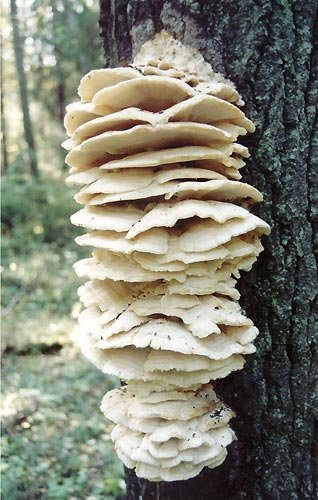Northern Climacodon (Climacodon septentrionalis)
- Dabeş: Basidiomycota (Basidiomycetes)
- Dabeşkirin: Agaricomycotina (Agaricomycetes)
- Çîn: Agaricomycetes (Agaricomycetes)
- Subclass: Incertae sedis (ji pozîsyona ne diyar)
- Siparîş: Polyporales (Polypore)
- Malbat: Phanerochaetaceae (Phanerochaetaceae)
- Cins: Climacodon (Climacodon)
- Awa: Climacodon septentrionalis (Northern Climacodon)
 laşê fêkî:
laşê fêkî:
climacodon northern consists of large leafy or tongue-shaped hats, fused at the base and forming large “whatnots”. The diameter of each hat is 10-30 cm, the thickness at the base is 3-5 cm. The color is grayish-yellowish, light; with age, it can fade to whitish or, conversely, turn green from mold. The edges of the caps are wavy, in young specimens they can be strongly bent down; the surface is smooth or somewhat pubescent. The flesh is light, leathery, thick, very dense, with a noticeable smell, defined by many as “unpleasant”.
Hymenophore:
spiny; spikes are frequent, thin and long (up to 2 cm), soft, rather brittle, in young mushrooms they are white, with age, like the cap, they change color.
Toza Sporê:
Spî
Belavbûn:
It occurs from mid-July in forests of various types, affecting weakened deciduous trees. Annual fruiting bodies may persist until autumn, but eventually are usually consumed by insects. Joints of northern climacodon can reach very impressive volumes – up to 30 kg.
Cureyên wekhev:
Given the spiny hymenophore and neat tiled growth, Climacodon septentrionalis is hard to confuse. There are references in the literature to the rare Creopholus cirrhatus, which is smaller and not as correct looking.
Inedible mushroom due to hard consistency









